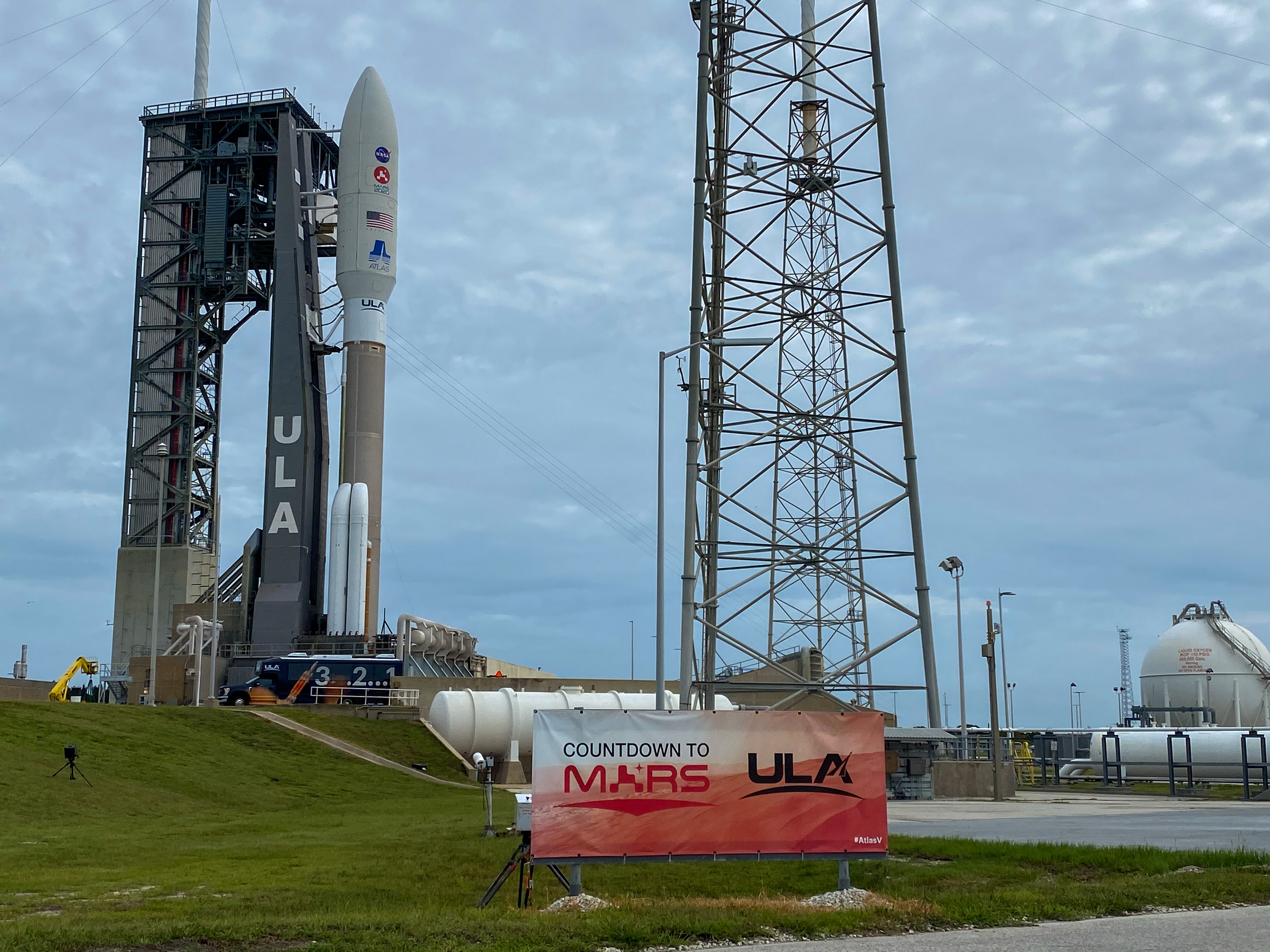NASA's next Mars rover, Perseverance, will launch today. Here's how to watch.
Liftoff is scheduled for 7:50 a.m. EDT (1150 GMT).
CAPE CANAVERAL, Fla. — NASA is counting down to the launch of its newest Mars rover. The car-sized robot, named Perseverance, is set to lift off toward the Red Planet today (July 30) during a two-hour window that opens at 7:50 a.m. EDT (1150 GMT), and you can watch it live.
Perseverance will launch atop a United Launch Alliance (ULA) Atlas V rocket from Space Launch Complex 41 here at Cape Canaveral Air Force Station. The rover will land on the floor of Mars' Jezero Crater on Feb.18, 2021.
Launch coverage will begin at 7 a.m. EDT (1100 GMT), with the launch window remaining open until about 9:50 a.m. EDT (1350 GMT). There will be multiple opportunities to launch within that time frame, and you can watch the launch live here on Space.com as well as via NASA. ULA will also offer a live webcast of the launch, beginning about 20 minutes before liftoff.
Live Updates: NASA's Mars rover Perseverance launch in real time!
The weather forecast looks good for tomorrow's planned liftoff, with an 80% chance of favorable conditions. Sunny skies are expected, with only minor concerns for cloud cover.
The mighty Atlas V rocket will launch in its 541 configuration. Dubbed the "Dominator" by ULA CEO Tory Bruno, this version of the Atlas V is the second-most powerful on the market. Accompanying the RD-180 main engine will be four strap-on solid rocket motors along with a Centaur upper stage. Together, the first stage and solid rocket motors will produce 2.3 million lbs. of thrust.
Related: NASA's Mars Perseverance rover to the Red Planet (photos)
Breaking space news, the latest updates on rocket launches, skywatching events and more!
Perseverance's journey to Mars will take approximately 6.5 months and will culminate in an intense landing sequence that NASA officials have dubbed "7 minutes of terror." Perseverance will have to deal with that terror by itself: Once the command to begin the landing sequence is initiated, the rover is on its own.
Following a successful landing, the rover will spend the next few years exploring the floor of the 28-mile-wide (45 kilometers) Jezero, which was home to a lake and river delta billions of years ago. NASA scientists have labeled the crater one of the most habitable places on (ancient) Mars.
Acting as a mobile geologist, the rover is equipped with a suite of scientific instruments designed to help it look for signs of past life. Perseverance is also packing 43 sample tubes that it will use to collect bits of Mars that a later mission will retrieve and send back to Earth. Over the course of its mission, the intrepid explorer will collect at least 20 samples, and preferably between 30 and 35, mission team members have said.
Perseverance's mission, a $2.7 billion project known as Mars 2020, is just the first leg in a multi-mission relay that will send the first samples back from another planet. NASA is teaming up with the European Space Agency to bring the samples back to Earth, potentially as early as 2031.
But before that can happen, Perseverance must launch. The rover was stacked on top of its rocket ride on July 7 and has spent the intervening weeks getting its power source installed and preparing for launch. To power the state-of-the-art rover, NASA is relying on a tried and true method: nuclear power.
Perseverance runs on the same power system that NASA's Curiosity Mars rover relies on — a plutonium-powered device known as a Multi-Mission Radioisotope Thermoelectric Generator. The generator takes heat from nuclear decay and converts it into electrical energy the rover can use to power its systems. The long-lasting energy source will be able to keep the rover warm and running for at least 14 years, way past the end of its planned mission.
Related: The search for life on Mars (a photo timeline)
In addition to caching samples, the rover will zap rocks and take plenty of pictures on its journey. As the rover looks for signs of life, it will also carry out a number of technology demonstrations that will be crucial to future missions not only to Mars but to other destinations in the solar system.
One such demonstration is the Mars Oxygen ISRU Experiment, or MOXIE for short. This piece of hardware will take carbon dioxide from the thin Martian atmosphere and convert it into breathable oxygen. As NASA looks to send humans to Mars in the 2030s, it needs to figure out how future astronauts will be able to breathe while also not having to transport their own supply of oxygen with them.
"This is a critical step on our way to sending humans to Mars," Zena Cardman, one of NASA's newest astronauts, told Space.com. "We want to make sure we get it right, and it's easier to do with robots before lives are at stake."
"This is an exciting time and a crucial piece of technology," she added.
Cardman, who is also a trained biologist, has a unique perspective on the upcoming launch. When asked if she was more excited about the potential of finding life on Mars or testing out future technologies that she herself might rely on one day, she told Space.com, "As a biologist, I can think of few, more profound questions than, Are we alone? It makes my spine tingle with excitement to think about that prospect."
Cardman explained that sometimes she gets asked if she thinks she missed out on the golden age of space exploration (meaning the Apollo era), but she thinks we're living in the golden age now.
"I think this is the most exciting time in space exploration," she said. "The fact that we're sending a rover to Mars while we talk about sending humans to the moon is incredible."
The Perseverance rover is part of NASA's Moon to Mars plan, an exploration program that aims to put a man and a woman back on the moon by 2024. That mission, and others in NASA's Artemis program of lunar exploration, is intended to be a stepping stone for eventual crewed missions to Mars.
When asked if she would jump at the chance to go to Mars, Cardman replied, "Yes!" She said that although NASA doesn't know which astronauts it will send to the moon just yet, she would certainly volunteer.
Follow Amy Thompson on Twitter @astrogingersnap. Follow us on Twitter @Spacedotcom or Facebook.

Amy Thompson is a Florida-based space and science journalist, who joined Space.com as a contributing writer in 2015. She's passionate about all things space and is a huge science and science-fiction geek. Star Wars is her favorite fandom, with that sassy little droid, R2D2 being her favorite. She studied science at the University of Florida, earning a degree in microbiology. Her work has also been published in Newsweek, VICE, Smithsonian, and many more. Now she chases rockets, writing about launches, commercial space, space station science, and everything in between.

